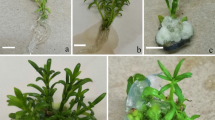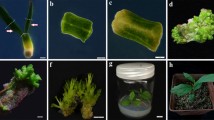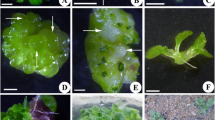Abstract
An efficient micropropagation system via direct shoot organogenesis from hypocotyl segments of Embelia ribes Burm F. was developed. A high frequency (84%) of adventitious shoot induction was obtained on Murashige and Skoog (MS) medium supplemented with additives (283.85 μM ascorbic acid [AA], 118.96 μM citric acid [CA], 142.33 μM cysteine, and 684.22 μM glutamine) and 1.13 μM of thidiazuron (TDZ) after 4 weeks following culture. Further development of shoot primordia into well-grown shoots of 4–5 cm in length was achieved by sub-culturing explants along with shoot primordia on MS medium supplemented with 0.44 μM benzyl adenine (BA) and 0.49 μM indole butyric acid (IBA) for three sub-culture periods with an interval of 15 days between them. The highest shoot multiplication was obtained when explants were incubated on MS medium supplemented with 2.2 μM BA and 0.49 μM IBA in 4 weeks. All in vitro developed shoots, 3–4 cm in length, rooted when grown on half-strength MS basal medium along with 2.47 μM IBA within 4 weeks. Moreover, 100% of shoots developed roots when these were treated with 4.93 μM IBA for 20 min and then transferred to pots containing soilrite mix and grown in the greenhouse. In vitro and ex vitro rooted plants showed a survival of 85 and 95% respectively, during hardening in the greenhouse for a 6-week period.

Similar content being viewed by others
Abbreviations
- AA:
-
Ascorbic acid
- ANOVA:
-
Analysis of variance
- BA:
-
Benzyl adenine
- CA:
-
Citric acid
- GA3 :
-
Gibberellic acid
- HF:
-
Hormone-free
- IBA:
-
Indolebutyric acid
- Kn:
-
6 furfuryl amino purine
- NAA:
-
α-naphthalene acetic acid
- NOA:
-
Naphthoxyacetic acid
- MS:
-
Murashige and Skoog medium
- PGR:
-
Plant growth regulator
- TDZ:
-
Thidiazuron (n-phenyl-n′-1, 2, 3-thidiazol-5-urea)
References
Anon (1990) The ayurvedic pharmacopoeia of India, part I, vol. II. Ministry of Health and Family Welfare, Government of India, pp 123–124
Anon (2002) The wealth of India—raw materials. National Institute of Science Communication, CSIR, New Delhi, pp 74–75
Anon (2008) National Medicinal Plants Board. Ministry of Health and Family Welfare press releases, Wednesday, February 27th 2008. Available online at: http://pib.nic.in/release/release.asp?relid=35664
Azad MAK, Yokota T, Ohkubo T, Andoh Y, Yahara S, Yoshizawa N (2005) In vitro regeneration of the medicinal woody plant Phellodendron amurense Rupr. through excised leaves. Plant Cell Tissue Organ Cult 80:43–50
Babaoglu M, Yorgancilar M (2000) TDZ-specific plant regeneration in salad burnet. Plant Cell Tissue Organ Cult 440:31–34
Barrueto Cid LP, Machado ACMG, Carvalheira SBRC, Brasileiro ACM (1999) Plant regeneration from seedling explants of Eucalyptus grandis × E. urophylla. Plant Cell Tissue Organ Cult 56:17–23
Başalma D, Uranbey S, Gürlek D, Özcan S (2008) TDZ-induced plant regeneration in Astragalus cicer L. Afr J Biotechnol 7(8):955–959
Cui M-L, Takayanagi K, Handa T (2004) High frequency of shoot regeneration from hypocotyls and stem segments of Antirrhinum majus (Snapdragon). Plant Cell Tissue Organ Cult 78:51–53
Faisal M, Ahmad N, Anis M (2005a) Shoot multiplication in Rauvolfia tetraphylla L. using thidiazuron. Plant Cell Tissue Organ Cult 80:187–190
Faisal M, Singh S, Anis M (2005b) In vitro regeneration and plant establishment of Tylophora indica (Burm. F.) Merrill: petiole callus culture. In Vitro Cell Dev Biol Plant 41(4):511–515
Fox JED, Barrett DR, Brand JE, Effendi M (1994) Germination of Santalum album L. Recent research in Western Australia and a protocol for Timor, Indonesia. Int J Ecol Environ Sci 20:345–356
Ghnaya AB, Charles G, Branchard M (2008) Rapid shoot regeneration from thin cell layer explants excised from petioles and hypocotyls in four cultivars of Brassica napus L. Plant Cell Tissue Organ Cult 92:25–30
Huang L-C, Huang B-L, Murashige TA (1998) Micropropagation protocol for Cinnamomum camphora. In Vitro Cell Dev Biol Plant 34:141–146
Joshi I, Bisht P, Sharma VK, Uniyal DP (2003) Studies on effect of nutrient media for clonal propagation of superior phenotypes of Dalbergia sissoo Roxb. through tissue culture. Silvae Genetica 52(3/4):143–147
Kaur K, Verma B, Kant U (1998) Plants obtained from the Khair tree (Acacia catechu Willd.) using mature nodal segments. Plant Cell Rep 17:427–429
Kim MK, Sommer HE, Bongarten BC, Merkle SA (1997) High-frequency induction of adventitious shoots from hypocotyl segments of Liquidambar styraciflua L. by thidiazuron. Plant Cell Rep 16:536–540
Koroch A, Juliani HR, Kapteyn J, Simon JE (2002) In vitro regeneration of Echinacea purpurea from leaf explants. Plant Cell Tissue Organ Cult 69:79–83
Kumar R, Sharma K, Agrawal V (2005) In vitro clonal propagation of Holarrhena antidysenterica (L.) Wall. through nodal explants from mature trees. In Vitro Cell Dev Biol Plant 41:137–144
Makunga NP, van Staden J (2008) An efficient system for the production of clonal plantlets of the medicinally important aromatic plant: Salvia africana-lutea L. Plant Cell Tissue Organ Cult 92:63–72
Martin KP (2003) Rapid axillary bud proliferation and ex vitro rooting of Eupatorium triplinerve. Biologia Plantarum 47(4):589–591
Martin KP, Beena MR, Joseph D (2003) High frequency axillary bud multiplication and ex vitro rooting of Wedelia chinensis (Osbeck) Merr.: a medicinal plant. Indian J Exp Biol 41(3):262–266
Mitra R (1995) ‘Vidanga’ (Embelia ribes)—an ayurvedic drug can help family planning. Appl Bot Abs 15(4):267–282
Murashige T, Skoog F (1962) A revised medium for rapid growth and bioassays with tobacco tissue cultures. Physiol Plant 15:473–497
Nagaveni HC, Srimathi RA (1981) Studies on germination of the sandal (Santalum album L.)—pre-treatment of sandal seeds. Indian For 107(6):348–354
Panse VG, Sukhatme PV (eds) (1978) Statistical methods for agricultural workers. ICAR, New Delhi, p 327
Raghu AV, Geetha SP, Martin G, Balachandran I, Ravindran P (2006) Direct shoot organogenesis from leaf explants of Embelia ribes Burm. F.: a vulnerable medicinal plant. J Forest Res 11:57–60
Rai VR (2002) Rapid clonal propagation of Nothapodytes foetida (Wight) sleumer—a threatened medicinal tree. In Vitro Cell Dev Biol Plant 38(4):347–351
Ravikumar K, Ved DK (2000) Hundred red listed medicinal plants of conservation concern in Southern India, 1st edn. Foundation for Revitalization of Local Health Traditions (FRLHT), Anugraha, Bangalore, pp 136–138
Sharma SK, Ramamurthy V (2000) Micropropagation of 4-year-old elite Eucalyptus tereticornis trees. Plant Cell Rep 19(5):511–518
Uranbey S, Sevimay CS, Özcan S (2005) Development of high frequency multiple shoot formation in Persian clover (Trifolium resupinatum L.). Plant Cell Tissue Organ Cult 80:229–232
Ved DK, Archna S, Ravikumar K (2003) Verifying vidanga. Amruth 7(3):11–12, 20
Acknowledgments
This study was carried out with the financial support of the Department of Science and Technology, Govt. of India, New Delhi. The authors are thankful to the Director of the Institute of Wood Science and Technology and the Group Coordinator of Research for the encouragement and providing the use of facilities. FRLHT, Bangalore, and the Karnataka State Forest Department are acknowledged for providing the plant material. The authors are grateful to Dr. Prasad Rallabhandi, M.S., Ph.D., Assistant Professor, Department of Microbiology and Immunology, University of Maryland, School of Medicine, 685W. Baltimore Street, Baltimore, MD21201, USA, for critically reading the manuscript and suggesting the necessary corrections.
Author information
Authors and Affiliations
Corresponding author
Rights and permissions
About this article
Cite this article
Annapurna, D., Rathore, T.S. Direct adventitious shoot induction and plant regeneration of Embelia ribes Burm F.. Plant Cell Tiss Organ Cult 101, 269–277 (2010). https://doi.org/10.1007/s11240-010-9684-x
Received:
Accepted:
Published:
Issue Date:
DOI: https://doi.org/10.1007/s11240-010-9684-x




